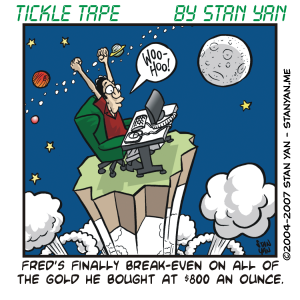In the trading business, it’s prudent to take everything you hear with a grain of salt. Our field is full of false prophets who claim they can make you rich quickly and easily. Realistic scepticism is healthy. For example, many traders made huge profits in the late 90s, and now claim that they can help you live comfortably by trading a $10,000 account. How do you do it? It’s easy, they claim. All you have to do is buy 200 shares of a $50 stock, wait for it to go up to $1 and make a $200 profit in as little as 30 minutes. That’s $400 an hour, $800,000 a year. Is this realistic? It doesn’t seem to be.
Sure, you can invest $10,000 on one trade, pick a stock that goes up to $1 and make a $400 profit, but can you do that over and over again? Won’t there be times when it went down $2? What about those times where you try to sell off the position, but you can get the $1 increase for only part of your position? Can you make a winning trade hour upon hour, day after day, without fail? It’s appealing.
Who wouldn’t want to believe it was true? But anyone who has traded the markets knows that it’s hard to make winning trades over and over without making a few losers, at a minimum. You can’t pin all your hopes on one trade, and you can’t believe that you’ll be able to repeat the process over and over again without fail. You must manage risk and constantly entertain the idea that you’ll hit upon a losing streak. It’s better to take a more realistic, practical approach to trade. It’s vital to be a realist.
What’s a realist? Professor Joseph Badaracco of Harvard Business School draws an important distinction between realism and cynicism in his book, “Leading Quietly.” “Realists understand that unpleasant surprises come with the territory. Caution, due diligence, and step-by-step planning are valuable, sometimes indispensable, but they don’t guarantee smooth sailing,” according to Badaracco. Realists don’t look at the world through rose-coloured glasses, but they don’t look at it through dark-tinted glasses either.
Both over-optimism and fatalistic pessimism are distortions of reality. Realists find a balance between the two extremes. They are open, flexible problem solvers. The cynic takes the attitude, “you can’t fight city hall,” but the realist believes there are times where you can work hard and do the impossible. It won’t work all the time, but many times it will.
When cynics put on a trade that is ruined by adverse events, they pessimistically think, “I got a raw deal.” Cynics aren’t ready for the unexpected. They view setbacks as evidence that the world is corrupt. They secretly believe that it’s impossible to make money in the markets and they are looking for evidence to throw in the towel. Realists know that unexpected adverse events are commonplace when trading the markets. Nothing is completely certain. It’s a matter of probabilities.
While cynics view the challenges of trading the markets as a reason to find a new profession, realists are open to change. They expect things to go wrong occasionally, and they are ready to deal with them. The realist is ready to rise to the challenge and work around the problems. They manage risk. They are on the constant lookout for new trading methods, and they know that they can’t passively wait for trading opportunities to come to them. They search for them and stay ahead of the masses.
So be a realist, not a cynic. Think positively, but don’t distort reality. Don’t fall for getting rich quick schemes. Get quality training and build up rock-solid trading skills. With enough persistence and effort, you can master the markets. There may be many setbacks, many losing trades, and endless dings to your ego, but if you are open to new experiences, and believe you can overcome any obstacle with hard work and persistence, then you will trade profitably and achieve enduring financial success.


